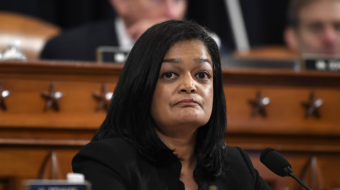
I have written before that the people’s movement that is now emerging doesn’t yet possess the transformative power of the movement of the 1930s. That movement set in motion an era of broad, deep-going, democratic, anti-corporate restructuring of our political and economic institutions – and also changed the thinking of tens of milliions.
But what today’s movement does possess is the potential to develop in that direction. All of which begs the question:
How do we accelerate this transition from a movement with transformative potential to a movement with transformative power and capacity?
Here are a few thoughts:
* Contrary to what some on the left think, the starting point of transformative politics isn’t political desires and wish list, but a sober and concrete assessment of the balance of class and social forces on the ground, not least of which is the political consciousness of the majority of working-class people and what they are ready to fight for.
And by this measure, a movement with transformative hopes must be up to its ears in the struggle for jobs, a higher minimum wage, immigration reform, gun control, infrastructure renewal, abortion rights, protecting the climate, preserving earned-benefit programs, marriage equality, voting rights, saving public education, reversing the sequester, winning a federal budget favoring people’s needs, cutting the military budget, and many more issues at the federal, state and local level.
It should also be an energetic part of the struggle to give the Republican Party a licking in next year’s congressional elections. Defeating right-wing extremist candidates is the key link in moving the whole chain of struggle forward. It will take an expansive coalition of voters, including independents, centrists and even some moderate Republicans.
Far from a diversion, these democratic struggles to protect, extend and deepen political, economic and social reforms and change the balance of forces in our nation’s capital and beyond are the incubator of a movement that possesses the necessary unity, understanding and capacity to effect more basic changes, which I will come back to below.
I realize that many people feel frustrated with the Democratic Party. Who doesn’t?
In the past 30 years the top layers of the Democratic Party have not fundamentally resisted the main direction of neoliberalism – that is, the supremacy of capitalist markets, deregulation, financialization, the pruning of government’s role, and an economics that redistributes wealth upward.
In fact, at many important turning points, Democratic Party leaders have brokered deals and greased the skids for neoliberal policies.
It was Bill Clinton who campaigned for NAFTA, squeezed the heart out of the safety net welfare program, lobbied hard for bank deregulation, and famously said, “The era of big government is over.”
At the same time, the Democratic Party has been a necessary, albeit inconsistent, component (at this stage of struggle) of the broad “small d” democratic coalition blocking the imposition of some of the worst features of the extreme right’s agenda, not to mention its more ambitious effort to gain unchallenged dominance over the federal government, thereby enabling the right to impose an authoritarian and austere form of capitalism on the American people.
Moreover, since 2008 the Obama administration has advanced many positive reform initiatives which the movement would be foolish not to welcome and support – the latest of which is the administration’s new efforts to curb carbon emissions.
Finally, the mass base of the Democratic Party includes major sections of the people’s movement and a substantial layer of progressive elected representatives who, while not completely happy with the centrist positions of its top leaders, are still not ready to bid goodbye and join a new political/electoral party.
In these circumstances, it would be foolhardy to refuse in advance to cooperate with the Democratic Party as a whole or sections of it under any conditions. That would be a prescription for marginalization.
Nor would it bring the movement any closer to building a new political vehicle that consistently speaks for a broad array of people and organizations who feel the crushing weight of the corporate class and its political sponsors. In fact, it would move its realization further away.
* Vital to building a transformative movement is an understanding of which social forces have to be brought together for progressive and radical change. Not any kind of movement can make fundamental change; it takes more than the left, more than progressives, more than radicalized youth. A transformative movement will only materialize to the extent that it is able to attract the working class and its organized sector, people of color, women and youth into its center.
New movements like Occupy can have a dramatic impact on the political discourse of the country and stimulate a surge of activity, but to see them as the hub of a broader movement with progressive and radical aspirations, as some did, betrays any understanding of the power relationships in capitalist society.
* A commitment to participate in every arena of struggle, flexible tactics, a readiness to employ various forms of struggle, and robust use of social media are imperative. The allergy that some on the left display toward electoral forms of struggle – sometimes dismissively called “electoralism” – is wrongheaded. As I see it, a movement that entertains transformative objectives will leave a larger and larger and increasingly independent electoral footprint on the political landscape going forward.
* A constant struggle for unity in all its forms is an overriding task. At its core is the fight against racism, male supremacy, nativism, homophobia and other forms of inequality and oppression.
The search for common ground and a common program of action is not at loggerheads with the fight for equality. In fact, the common ground will be wider, deeper and more durable to the degree that the broader movement vigorously fights for equality in all its forms.
In recent decades vast political, economic, social and demographic transformations have occurred, but the fight for full racial equality retains its overarching importance. And white people and white workers in their own interests should be in the middle of this fight.
* The revitalization of the movement’s own political and organizational capacities to reach, mobilize, and unite millions is an essential part of the mix. For a number of years people’s organizations and the left – all of which are too small and not yet fully attuned to the times in which we live (and I include the Communist Party here) – have been exploring new ways of thinking and organizing in order to expand their size, influence, and power. Some successes have been achieved no doubt, but this process of renewal and growth has a still considerable distance to go.
* A vision of deep-going democratization (radical reforms) of our economic and political institutions has to be combined with small bore reform struggles. In this era of economic stagnation, multiple crises and shrinking democracy, the reforms applied in the post-World-War-II period no longer suffice. What is needed is a program that breathes new life into our democracy and challenges the logic, profits, prerogatives and growth imperative of corporate capitalism. Among other things, some public ownership is in order at the level of the commanding heights of economy (for example, the financial sector) and an expansion of worker/locally owned and operated businesses.
* A willingness to challenge the harmful growth of the coercive powers of the state and the military-industrial complex with its far-flung network of bases, both of which are rationalized in the name of fighting the “war on terror,” can’t be sidestepped.
* Transforming the economy along sustainable lines and make the world a habitable for human beings and other species is an existential imperative. In the words of the notable climate scientist James Hansen, we are facing a “planetary emergency.”
* “Keep Hope Alive.” The three-decades-old neoliberal corporate offensive, ramrodded first of all by right-wing extremism, galvanized resistance. But it also crushed the hopes of countless numbers of people in the possibility of social change. Thus a task of a movement with transformative desires is to articulate a compelling and hopeful narrative that convinces millions that collective avenues of action will bring changes for the better in their everyday lives.
The above is not meant to be exhaustive, but only to outline in broad strokes some directions that the people’s movement should consider in order to qualitatively ramp up its transformative power and capacity. I’m sure readers of People’s World have other ideas on this subject that merit close consideration as well. So let’s compare notes and in the meantime continue to fight the good fight.
Photo: Mural in East Germantown, Philadelphia. MTSOfan CC 2.0










